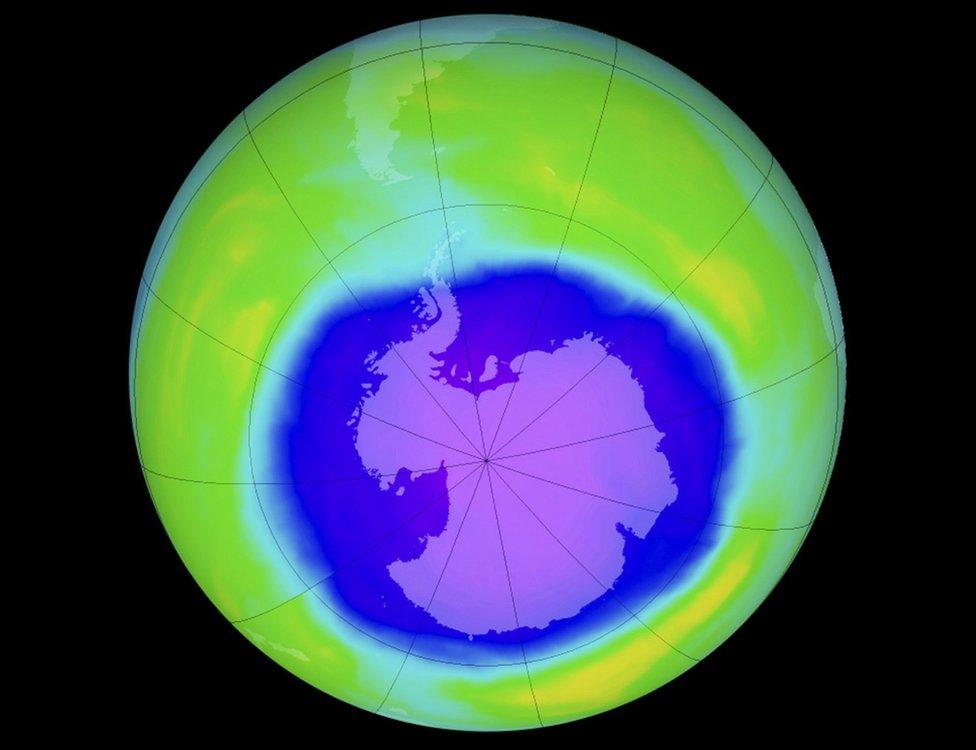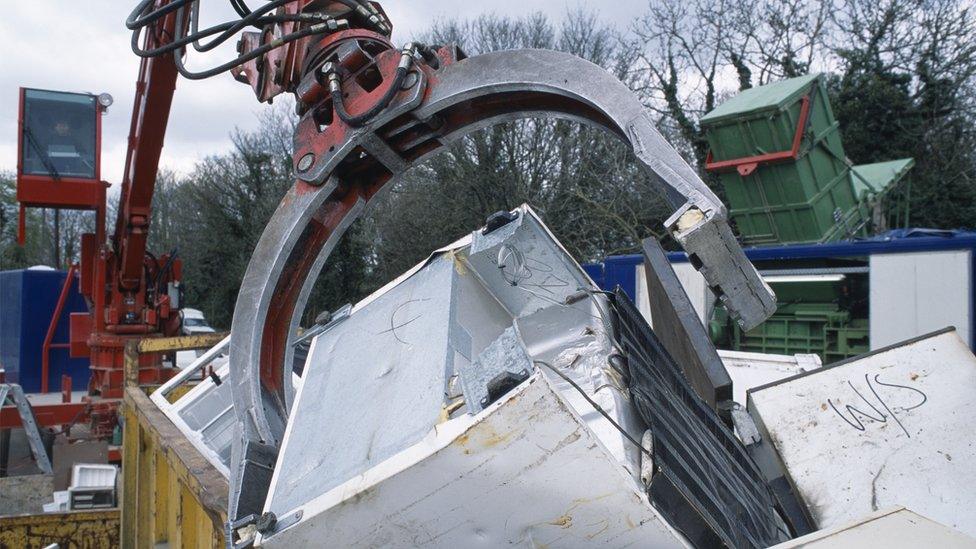'Healing' detected in Antarctic ozone hole
- Published
- comments

The researchers believe that healing of the ozone hole has begun in the stratosphere above Antarctica
Researchers say they have found the first clear evidence that the thinning in the ozone layer above Antarctica is starting to heal.
The scientists said that in September 2015 the hole was around 4 million sq km smaller than it was in the year 2000 - an area roughly the size of India.
The gains have been credited to the long term phasing out of ozone-destroying chemicals.
The study, external also sheds new light on the role of volcanoes in making the problem worse.
Skin cancer worry
The natural production and destruction of ozone in the stratosphere balances itself out over long time, meaning that historically there has been a constant level to protect the Earth by blocking out harmful ultraviolet radiation from the Sun.
Its absence increases the chances of skin cancer, cataract damage, and harm to humans, animals and plants.
British scientists first noticed a dramatic thinning of ozone in the stratosphere some 10 kilometres above Antarctica in the mid 1980s.
In 1986, US researcher Susan Solomon showed that ozone was being destroyed by the presence of molecules containing chlorine and bromine that came from chlorofluorocarbons (CFCs). These gases were found in everything from hairsprays to refrigerators to air conditioning units.
The reason the thinning was occurring mainly over Antarctica was because of the extreme cold and large amounts of light. These helped produce what are termed Polar Stratospheric Clouds, external.
In these chilled-out clouds, the chlorine chemistry occurs that destroys the ozone.
Thanks to the global ban on the use of CFCs in the Montreal Protocol, external in 1987, the situation in Antarctica has been slowly improving.
Several studies have shown the declining influence of CFCs, but according to the authors this new study shows the "first fingerprints of healing" and the ozone layer is actively growing again.
Prof Solomon and colleagues, including researchers from the University of Leeds in the UK, carried out detailed measurements of the amount of ozone in the stratosphere between 2000 and 2015.
Using data from weather balloons, satellites and model simulations, they were able to show that the thinning of the layer had declined by 4 million sq km over the period. The found that more than half the shrinkage was due solely to the reduction in atmospheric chlorine.
Normally measurements are taken in October when the ozone hole is at its largest. But this team believed they would get a better picture by looking at readings taken in September, when temperatures are still low but other factors that can influence the amount of ozone, such as the weather, are less prevalent.
"Even though we phased out the production of CFCs in all countries including India and China around the year 2000, there's still a lot of chlorine left in the atmosphere," Prof Solomon told the BBC World Service Science in Action programme.
"It has a lifetime of about 50-100 years, so it is starting to slowly decay and the ozone will slowly recover.
"We don't expect to see a complete recovery until about 2050 or 2060 but we are starting to see that in September the ozone hole is not as bad as it used to be."

Refrigerators were once a major source of CFC gases that damaged the ozone layer
One finding that puzzled researchers was the October 2015 reading that showed the biggest ozone hole on record over Antarctica.
The scientists believe that a key contributor to the record hole was volcanic activity.
"After an eruption, volcanic sulphur forms tiny particles and those are the seeds for Polar Stratospheric Clouds," Prof Solomon told Science in Action.
"You get even more of these clouds when you have a recent major volcanic eruption and that leads to additional ozone loss."
"Until we did our recent work no-one realised that the Calbuco eruption in Chile, actually had significantly affected the ozone loss in October of last year."
The study has been hailed as "historically significant" by some other researchers in the field.
"This is the first convincing evidence that the healing of the Antarctic ozone hole has now started," said Dr Markus Rex from the Alfred Wegener Institute for Polar and Marine Research in Germany.
"Right now the state of the ozone layer is still really bad, but I find it very important that we know the Montreal Protocol is working and has an effect on the size of the hole and that is a big step forward."
Differing views
However others are not entirely convinced that the decline shown in the new study is down to a reduction in the amount of chlorine in the stratosphere.
"The data clearly show significant year to year variations that are much greater than the inferred trends shown in the paper," said Dr Paul Newman from Nasa.
"If the paper included this past year, which had a much more significant ozone hole due to lower wave driven forcing, the overall trend would be less."
Regardless of these questions, the scientists involved in the study believe the ozone story is a great role model for how to tackle global environmental problems.
"It's just been remarkable," said Prof Solomon.
"This was an era in which international co-operation went rather well on some issues. I was inspired by the way the developed and developing countries were able to work together on dealing with the ozone hole," said Prof Solomon.
The study has been published in the journal, external Science.
Follow Matt on Twitter @mattmcgrathbbc, external and on Facebook.